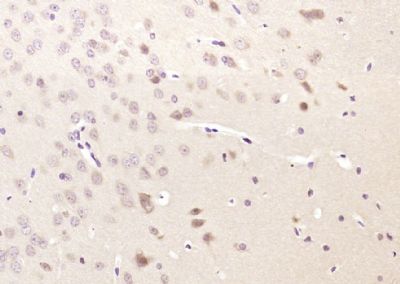GARNL1 Polyclonal Antibody
Purified Rabbit Polyclonal Antibody (Pab)
- SPECIFICATION
- CITATIONS
- PROTOCOLS
- BACKGROUND

Application
| IHC-P, IHC-F, IF, ICC, E |
|---|---|
| Primary Accession | Q6GYQ0 |
| Reactivity | Rat, Pig, Dog, Bovine |
| Host | Rabbit |
| Clonality | Polyclonal |
| Calculated MW | 230 KDa |
| Physical State | Liquid |
| Immunogen | KLH conjugated synthetic peptide derived from human GARNL1 |
| Epitope Specificity | 631-730/2036 |
| Isotype | IgG |
| Purity | affinity purified by Protein A |
| Buffer | 0.01M TBS (pH7.4) with 1% BSA, 0.02% Proclin300 and 50% Glycerol. |
| SUBCELLULAR LOCATION | Cytoplasmic and Nuclear. Translocated to the nucleus when associated with TCF3/E12. |
| SIMILARITY | Contains 1 Rap-GAP domain. |
| SUBUNIT | Component of the heterodimeric RalGAP1 complex with RALGAPB. Heterodimerization is required for activity. Interacts with the HLH region of TCF3/isoform E12 (By similarity). |
| Important Note | This product as supplied is intended for research use only, not for use in human, therapeutic or diagnostic applications. |
| Background Descriptions | GARNL1 is expressed during embryogenesis with E12. During development, GARNL1 expression decreases, persisting at high levels only in neurons of the adult brain. GARNL1 localizes to the cytoplasm where it may play a role regulating GTP hydrolysis of proteins such as Ran and Rap. GARNL1 is imported to the nucleus via dimerization with E12. GARNL1 interacts with the HLH region of E12 and may function to negatively regulate the transcription of E12-dependent downstream target genes. This suggests that at least a portion of the function of GARNL1 is dependent upon its association with E12. GARNL1 may also associate with other HLH proteins and influence a variety of HLH signaling cascades. In adult brain, GARNL1 activity does not involve E12 and therefore it may serve a different function in developed neural tissue. |
| Gene ID | 253959 |
|---|---|
| Other Names | Ral GTPase-activating protein subunit alpha-1, GAP-related-interacting partner to E12, GRIPE, GTPase-activating Rap/Ran-GAP domain-like 1, Tuberin-like protein 1, p240, RALGAPA1, GARNL1, KIAA0884, TULIP1 |
| Target/Specificity | Widely expressed. |
| Dilution | IHC-P=1:100-500,IHC-F=1:100-500,ICC=1:100-500,IF=1:100-500,ELISA=1:5000-10000 |
| Storage | Store at -20 ℃ for one year. Avoid repeated freeze/thaw cycles. When reconstituted in sterile pH 7.4 0.01M PBS or diluent of antibody the antibody is stable for at least two weeks at 2-4 ℃. |
| Name | RALGAPA1 |
|---|---|
| Synonyms | GARNL1, KIAA0884, TULIP1 |
| Function | Catalytic subunit of the heterodimeric RalGAP1 complex which acts as a GTPase activator for the Ras-like small GTPases RALA and RALB. |
| Cellular Location | Cytoplasm. Nucleus. Note=Translocated to the nucleus, when associated with TCF3/E12 |
| Tissue Location | Widely expressed.. |

Thousands of laboratories across the world have published research that depended on the performance of antibodies from Abcepta to advance their research. Check out links to articles that cite our products in major peer-reviewed journals, organized by research category.
info@abcepta.com, and receive a free "I Love Antibodies" mug.
Provided below are standard protocols that you may find useful for product applications.
If you have used an Abcepta product and would like to share how it has performed, please click on the "Submit Review" button and provide the requested information. Our staff will examine and post your review and contact you if needed.
If you have any additional inquiries please email technical services at tech@abcepta.com.













 Foundational characteristics of cancer include proliferation, angiogenesis, migration, evasion of apoptosis, and cellular immortality. Find key markers for these cellular processes and antibodies to detect them.
Foundational characteristics of cancer include proliferation, angiogenesis, migration, evasion of apoptosis, and cellular immortality. Find key markers for these cellular processes and antibodies to detect them. The SUMOplot™ Analysis Program predicts and scores sumoylation sites in your protein. SUMOylation is a post-translational modification involved in various cellular processes, such as nuclear-cytosolic transport, transcriptional regulation, apoptosis, protein stability, response to stress, and progression through the cell cycle.
The SUMOplot™ Analysis Program predicts and scores sumoylation sites in your protein. SUMOylation is a post-translational modification involved in various cellular processes, such as nuclear-cytosolic transport, transcriptional regulation, apoptosis, protein stability, response to stress, and progression through the cell cycle. The Autophagy Receptor Motif Plotter predicts and scores autophagy receptor binding sites in your protein. Identifying proteins connected to this pathway is critical to understanding the role of autophagy in physiological as well as pathological processes such as development, differentiation, neurodegenerative diseases, stress, infection, and cancer.
The Autophagy Receptor Motif Plotter predicts and scores autophagy receptor binding sites in your protein. Identifying proteins connected to this pathway is critical to understanding the role of autophagy in physiological as well as pathological processes such as development, differentiation, neurodegenerative diseases, stress, infection, and cancer.


